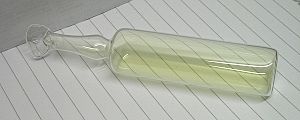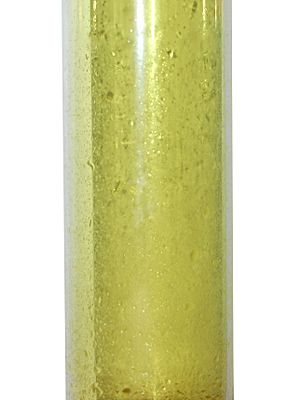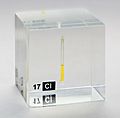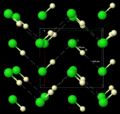Chlorine facts for kids
Chlorine (chemical symbol Cl) is a fascinating chemical element. It's number 17 on the periodic table, meaning it has 17 protons. Chlorine is part of a special group called halogens, which are known for being very reactive. Its atomic mass is about 35.45.
Contents
What is Chlorine Like?
Physical Features of Chlorine
Chlorine is a gas that looks greenish-yellow. It has a very strong smell, much like bleach. This gas can be irritating if you breathe it in. If you cool it down enough, chlorine turns into a liquid. It is also heavier than air, which means it can settle in low places.
How Chlorine Reacts
Chlorine is a very active element. It reacts with many other substances to form new compounds called chlorides. It is more reactive than bromine but less reactive than fluorine. Chlorine can even cause some things to burn, similar to how oxygen does.
When chlorine dissolves in water, it creates a mix of two acids: hypochlorous acid and hydrochloric acid. The amount of each acid depends on how acidic or basic the water is. Chlorine also reacts with bromides and iodides to create bromine and iodine.
Chlorine Compounds
Chlorine can combine with other elements in different ways. The most common way is in chlorides, where chlorine is not very reactive.
Other compounds include:
- Hypochlorites: These are strong oxidizers, meaning they can take electrons from other substances. A common one is in bleach.
- Chlorites: These contain chlorine in a different form.
- Chlorine dioxide: This is another common chlorine compound, but it's not a chloride.
- Chlorates: These compounds also have strong oxidizing power.
- Perchlorates: These are the least reactive of these types of chlorine compounds.
Many organic compounds also contain chlorine. For example, Freon used to have chlorine in it. PVC (Poly-vinyl chloride), a very common type of plastic, also contains chlorine.
Chlorine can form compounds with oxygen, called chlorine oxides. However, most of these are very reactive and don't last long.
Where is Chlorine Found?
You won't find pure chlorine as an element in nature. Instead, it's usually found combined with other elements. The most common source of chlorine is sodium chloride, which is regular table salt. You can find it dissolved in the ocean as sea salt, or underground as rock salt. Some organic compounds in nature also contain chlorine.
How Chlorine is Made
Most chlorine is made using a process called electrolysis. This involves passing electricity through a solution of sodium chloride (salt water). This method is known as the chloralkali process.
Chlorine can also be made in a lab. One way is by reacting manganese dioxide with hydrochloric acid. Another way is when sodium hypochlorite reacts with hydrochloric acid. This last reaction can be dangerous because it might happen without anyone knowing.
What is Chlorine Used For?
Chlorine has many important uses:
- Water purification: It's widely used to clean water, especially in swimming pools, to kill germs.
- Disinfectant and bleach: It helps kill bacteria and whiten clothes.
- Making other chemicals: Chlorine is a key ingredient in making many important compounds, like chloroform and carbon tetrachloride.
- Historical use: It was used as a gas in some wars.
History of Chlorine
Chlorine was first discovered in 1774 by a scientist named Carl Wilhelm Scheele. He thought it contained oxygen. However, in 1810, Humphry Davy proved that it was a unique element and gave it the name "chlorine." By 1918, the United States began adding chlorine to all its public water supplies to make them safer.
Safety with Chlorine
Chlorine can be poisonous if you are exposed to large amounts. If you breathe it in, it can badly irritate your lungs, eyes, and skin. Because chlorine is very reactive, it can also cause fires with some materials. Since it is heavier than air, it can collect in enclosed spaces, making them dangerous.
Related pages
- List of common elements
- Chlorine compounds
| Periodic table | |||||||||||||||||||||||||||||||||||||||||
|---|---|---|---|---|---|---|---|---|---|---|---|---|---|---|---|---|---|---|---|---|---|---|---|---|---|---|---|---|---|---|---|---|---|---|---|---|---|---|---|---|---|
| H | He | ||||||||||||||||||||||||||||||||||||||||
| Li | Be | B | C | N | O | F | Ne | ||||||||||||||||||||||||||||||||||
| Na | Mg | Al | Si | P | S | Cl | Ar | ||||||||||||||||||||||||||||||||||
| K | Ca | Sc | Ti | V | Cr | Mn | Fe | Co | Ni | Cu | Zn | Ga | Ge | As | Se | Br | Kr | ||||||||||||||||||||||||
| Rb | Sr | Y | Zr | Nb | Mo | Tc | Ru | Rh | Pd | Ag | Cd | In | Sn | Sb | Te | I | Xe | ||||||||||||||||||||||||
| Cs | Ba | La | Ce | Pr | Nd | Pm | Sm | Eu | Gd | Tb | Dy | Ho | Er | Tm | Yb | Lu | Hf | Ta | W | Re | Os | Ir | Pt | Au | Hg | Tl | Pb | Bi | Po | At | Rn | ||||||||||
| Fr | Ra | Ac | Th | Pa | U | Np | Pu | Am | Cm | Bk | Cf | Es | Fm | Md | No | Lr | Rf | Db | Sg | Bh | Hs | Mt | Ds | Rg | Cn | Uut | Fl | Uup | Lv | Uus | Uuo | ||||||||||
|
|||||||||||||||||||||||||||||||||||||||||
Images for kids
-
Carl Wilhelm Scheele, discoverer of chlorine
-
Hydrated nickel(II) chloride.
-
Yellow chlorine dioxide (ClO2) gas above a solution.
-
Ignaz Semmelweis, a pioneer in hygiene.
See also
 In Spanish: Cloro para niños
In Spanish: Cloro para niños



















